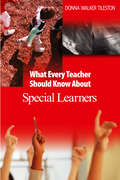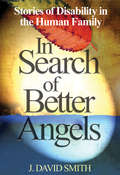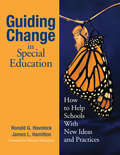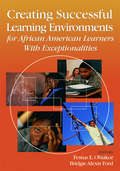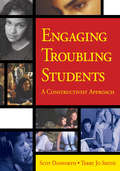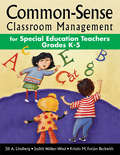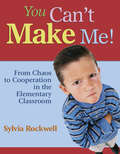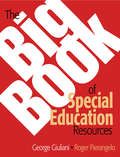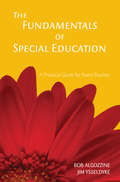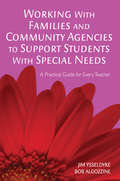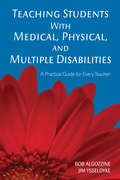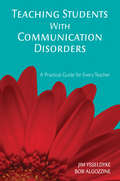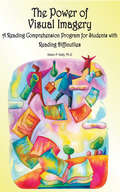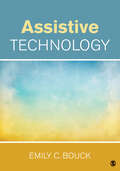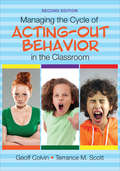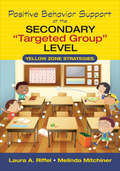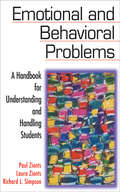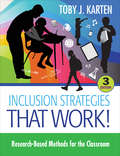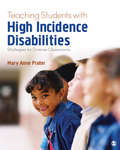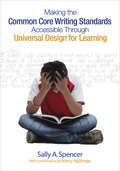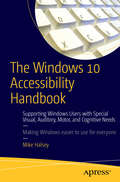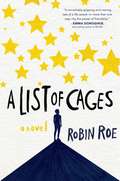- Table View
- List View
What Every Teacher Should Know About Special Learners
by Donna E. TilestonThis resource will help you differentiate content for special learners by identifying special programs and the laws and regulations that govern those programs.
In Search of Better Angels: Stories of Disability in the Human Family
by J. David SmithThis resource is a testament to the value of people with disabilities and the enrichment that we can find with them.
Guiding Change in Special Education: How to Help Schools With New Ideas and Practices
by Dr Ronald G. Havelock James L. HamiltonThis practical, step-by-step guide illustrates and describes the seven stages of school change and provides explanations and advice for incorporating each stage into your change process.
Creating Successful Learning Environments for African American Learners With Exceptionalities
by Dr Festus E. Obiakor Dr Bridgie Alexis FordIn this groundbreaking book, more than 25 leading scholars and practitioners provide concrete solutions for maximizing African American students' achievement.
Engaging Troubling Students: A Constructivist Approach
by Scot Danforth Terry Jo SmithFilled with rich narrative and designed for educators working with troubling students each day, this insightful, practical guide leads you in developing helpful, trusting student-teacher relationships.
Common-Sense Classroom Management for Special Education Teachers, Grades K-5
by Jill A. Lindberg Judith K. Walker-Wied Kristin M. BeckwithThis practical guide gives teachers simple strategies for organizing their classrooms and pacing their day to ensure that learners with special needs experience success.
You Can't Make Me!: From Chaos to Cooperation in the Elementary Classroom
by Sylvia RockwellOffering effective methods for teaching appropriate behavior to students who are defiant and disruptive, this book includes real-life teaching anecdotes, research-based strategies, and a unique parent supplement.
The Big Book of Special Education Resources
by George A. Giuliani Roger PierangeloSave time and frustration with this definitive special education resource to locate specialized clearinghouses and disability organizations, toll-free numbers, publications, state-specific entities, and more.
The Fundamentals of Special Education: A Practical Guide for Every Teacher
by Bob Algozzine Dr James E. YsseldykeThis guide highlights major concepts in special education—from disability categories, identification issues, and IEPs to appropriate learning environments and the roles general and special educators play.
Working With Families and Community Agencies to Support Students With Special Needs: A Practical Guide for Every Teacher
by Dr James E. Ysseldyke Bob AlgozzineTeachers will find practical guidelines for collaborating with families, applying early childhood intervention, using transition services, involving community agencies and businesses, and identifying post-high school options.
Teaching Students With Medical, Physical, and Multiple Disabilities: A Practical Guide for Every Teacher
by Bob Algozzine Dr James E. YsseldykeLearn about assistive technologies, helpful adjustments to school and classroom environments, and effective instructional modifications specifically designed to support students with medical, physical, and multiple disabilities.
Teaching Students With Communication Disorders: A Practical Guide for Every Teacher
by Dr James E. Ysseldyke Bob AlgozzineFocusing on teaching students with communication disorders, the authors offer practical teaching strategies and provide brief definitions, indicators, and behaviors associated with speech and language disorders.
The Power of Visual Imagery: A Reading Comprehension Program for Students with Reading Difficulties
by Karen Patricia KellyFormerly published by Peytral PublicationsThis user-friendly resource provides the theory for improving students' reading skills through visual imagery, plus actual lesson plans to use independently or alongside your language arts program.
Assistive Technology: Gargiulo: Special Education In Contemporary Society 5e + Bouck: Assistive Technology
by Emily C. BouckSuccinct, yet comprehensive, Assistive Technology is designed to help educators better understand assistive technology and how it can support students with disabilities from early childhood through the transition into adulthood. This practical book is organized around the purpose of technology and the support it can provide rather than a student’s disability categorization. Grounded in research and filled with engaging case studies and activities, author Emily C. Bouck offers an unbiased depiction of the advantages and limitations of technology. Readers are exposed to a full range of assistive technology including up-to-date coverage of low- and high-technology, as well as free and for-purchase options that can be used to support students with disabilities.
Assistive Technology: Gargiulo: Special Education In Contemporary Society 5e + Bouck: Assistive Technology
by Emily C. BouckSuccinct, yet comprehensive, Assistive Technology is designed to help educators better understand assistive technology and how it can support students with disabilities from early childhood through the transition into adulthood. This practical book is organized around the purpose of technology and the support it can provide rather than a student’s disability categorization. Grounded in research and filled with engaging case studies and activities, author Emily C. Bouck offers an unbiased depiction of the advantages and limitations of technology. Readers are exposed to a full range of assistive technology including up-to-date coverage of low- and high-technology, as well as free and for-purchase options that can be used to support students with disabilities.
Managing the Cycle of Acting-Out Behavior in the Classroom
by Terrance M. Scott Geoffrey T. ColvinMinimize problem behavior and maximize student success! Acting-out behavior by students manifests in ways that make classroom management and teaching very challenging. Building on a model using seven phases of acting-out behavior presented in the first edition, the newly updated edition draws on new research in applied behavior analysis, sound instructional principles, and functional behavior assessment to deliver a clear roadmap for educators to design interventions in a clear, systematic, and achievable matter. Features include: Managing each phase of the acting-out cycle—from structuring the classroom, to handling escalated behavior, to recovery Case studies that distill concrete action steps from the book’s concepts Checklists, tools, resources, and templates for applying the book’s principles to any classroom
Positive Behavior Support at the Secondary "Targeted Group" Level: Yellow Zone Strategies
by Laura A. Riffel Melinda S. MitchinerSeal the gaps in student learning with targeted intervention Research on positive behavior support has focused largely on tier one, school-wide disciplinary policies, and tier three interventions tailored to highly problematic students. This leaves a gap in the middle. "Yellow zone", or tier two, interventions are an extremely effective way to address many challenging behavior and disciplinary issues in small group settings. Positive Behavior Support at the Secondary "Targeted Group" Level shows teachers how to identify the students who can benefit from tier two interventions and demonstrates how to create an implementation plan that delivers results. Focusing on proactive strategies rather than reactive solutions, Riffel and Mitchiner’s research-based techniques include: General strategies that can be applied at the individual student level, such as self-management, proximity control, and the Premack principle and peer mentoring Comprehensive action plans that anticipate the full range of disruptions that may occur A useful behavior rating sheet proven effective in improving student behavior "Funk Sway" For The Classroom: Using Feng Shui principles to create a classroom environment that enhances productivity, learning, and creativity Apply the techniques in this book to reduce challenging behavior, improve school climate, and improve outcomes for ALL students. "This book is easy to read, understand, and implement in any classroom or school. Teachers will be drawn to the resources that can be copied and used immediately! I can’t wait to apply some of these practices in my classroom!" Rachel Spenner, Sixth Grade Teacher Westridge Elementary School
Emotional and Behavioral Problems: A Handbook for Understanding and Handling Students
by Richard L. Simpson Paul Zionts Laura T. ZiontsThe authors take a complex, under-discussed topic and give teachers and administrators useful, basic guidelines they can put to use quickly in understanding, identifying, and helping this special group of students.
Inclusion Strategies That Work!: Research-Based Methods for the Classroom
by Toby J. KartenThe go-to book for including ALL learners in educational success! Teaching students with diverse needs require educators to employ empathy, responsiveness, and patience. This book has long been the indispensable resource for K-12 teachers as they confidently form lesson plans and strategies for inclusion. In this new edition, Toby J. Karten’s data-driven methods are updated with the latest research and policy developments. The book’s content includes: Updated information on ADA, IDEA, writing IEPs, transitional services, classifications, RTI, metacognitive strategies, and links to the Common Core Tips for working with families and making them an integral part of the inclusive team An overview of special education legislative terminology Interactive online forms for planning, documentation, and collaboration
Inclusion Strategies That Work!: Research-Based Methods for the Classroom
by Toby J. KartenThe go-to book for including ALL learners in educational success! Teaching students with diverse needs require educators to employ empathy, responsiveness, and patience. This book has long been the indispensable resource for K-12 teachers as they confidently form lesson plans and strategies for inclusion. In this new edition, Toby J. Karten’s data-driven methods are updated with the latest research and policy developments. The book’s content includes: Updated information on ADA, IDEA, writing IEPs, transitional services, classifications, RTI, metacognitive strategies, and links to the Common Core Tips for working with families and making them an integral part of the inclusive team An overview of special education legislative terminology Interactive online forms for planning, documentation, and collaboration
Teaching Students With High-Incidence Disabilities: Strategies for Diverse Classrooms
by Mary Anne PraterTo ensure that all students receive quality instruction, Teaching Students with High-Incidence Disabilities prepares preservice teachers to teach students with learning disabilities, emotional behavioral disorders, intellectual disabilities, attention deficit hyperactivity, and high functioning autism. It also serves as a reference for those who have already received formal preparation in how to teach special needs students. Focusing on research-based instructional strategies, Mary Anne Prater gives explicit instructions and includes models throughout in the form of scripted lesson plans. The book also has a broad emphasis on diversity, with a section in each chapter devoted to exploring how instructional strategies can be modified to accommodate diverse exceptional students. Real-world classrooms are brought into focus using teacher tips, embedded case studies, and technology spotlights to enhance student learning.
Teaching Students With High-Incidence Disabilities: Strategies for Diverse Classrooms
by Mary Anne PraterTo ensure that all students receive quality instruction, Teaching Students with High-Incidence Disabilities prepares preservice teachers to teach students with learning disabilities, emotional behavioral disorders, intellectual disabilities, attention deficit hyperactivity, and high functioning autism. It also serves as a reference for those who have already received formal preparation in how to teach special needs students. Focusing on research-based instructional strategies, Mary Anne Prater gives explicit instructions and includes models throughout in the form of scripted lesson plans. The book also has a broad emphasis on diversity, with a section in each chapter devoted to exploring how instructional strategies can be modified to accommodate diverse exceptional students. Real-world classrooms are brought into focus using teacher tips, embedded case studies, and technology spotlights to enhance student learning.
Making the Common Core Writing Standards Accessible Through Universal Design for Learning
by Sally A. SpencerUnlock hidden writing skills in all learners through UDL! The Common Core State Standards (CCSS) for writing are promising but are challenging to implement, especially for struggling students. Sally A. Spencer demonstrates the promise of Universal Design for Learning (UDL) as a framework for making the CCSS writing and language standards accessible to all kids. Educators who utilize these strategies will know: How to leverage the strengths of students to optimize writing instruction and overcome their weaknesses The ways UDL can minimize the roadblocks in CCSS implementation How to - and how not to - use technology to teach writing and language conventions
The Windows 10 Accessibility Handbook
by Mike HalseyLearn everything you need to know about making Windows 10 easier to use, see, hear, touch, or read, whether you are using it yourself, setting it up for another person, teaching others about ease of use at work or in the home, or working with a variety of people with specific needs in the community. What you'll learn Manage accessibility in the Settings app, and make use of the Ease of Access Center Make your keyboard and mouse easier to use Make text and windows easier to read Use text or visual alternatives for sounds Use the narrator, and control it using touch and with the keyboard Use Cortana as a smart PC assistant Make use of Windows 10 shortcut keys, and touch and trackpad gestures Use and train the handwriting recognition feature Dictate or navigate using speech recognition Who this book is for The audience for this book includes (but is not limited to) Windows users with special visual, auditory, motor, and cognitive needs, at home and in the workplace. It provides guidance for IT and management professionals who work with such users, as well as the community and statutory groups, organizations, colleges, universities, and government agencies that support them. It is also a guide for friends and family supporting elderly or disabled Windows users in the home, and for anyone else looking for advice on how to make their PC simpler, easier, more productive, and ultimately more enjoyable to use. Table of Contents Chapter 1: Introducing Accessibility in Windows 10 Chapter 2: Identifying Your Needs Chapter 3: Using Windows 10 with a Visual Impairment Chapter 4: Using Windows 10 with a Hearing Impairment Chapter 5: Making the Keyboard and Mouse Easier to Use Chapter 6: Touch and Alternative Input Options Chapter 7: Windows 10 for Memory, Learning, or Other Cognitive Impairments Chapter 8: Managing Accessibility in Windows 10 Mobile Chapter 9: Windows 10 Usability Tips and Tricks
A List of Cages
by Robin Roe<p>When Adam Blake lands the best elective ever in his senior year, serving as an aide to the school psychologist, he thinks he's got it made. Sure, it means a lot of sitting around, which isn't easy for a guy with ADHD, but he can't complain, since he gets to spend the period texting all his friends. Then the doctor asks him to track down the troubled freshman who keeps dodging her, and Adam discovers that the boy is Julian--the foster brother he hasn't seen in five years. <p>Adam is ecstatic to be reunited. At first, Julian seems like the boy he once knew. He's still kind hearted. He still writes stories and loves picture books meant for little kids. But as they spend more time together, Adam realizes that Julian is keeping secrets, like where he hides during the middle of the day, and what's really going on inside his house. Adam is determined to help him, but his involvement could cost both boys their lives. <p>First-time novelist Robin Roe relied on life experience when writing this exquisite, gripping story featuring two lionhearted characters.
